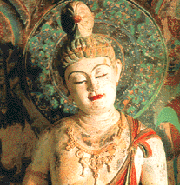The Power of Mantra
Buddhism says that we all want happiness but we seem to experience unhappiness.
This causes a flawed perception of oneself.
Suffering hurts us but ironically it is caused by ourselves. It makes sense that
we would only hurt the people or things we don't like, therefore the logical assumption
then becomes that we must not like ourselves. The self-hating opinion appears
to be the root of pain and suffering.
To overcome this, Buddhism states that we need to recognise our fundamental goodness.
In essence, we need to develop positive self-esteem.
Mantra is an affirmation. It helps to affirm a truth about ourselves. Thus every
time this mantra is repeated an energy is created within you which dissolves negative
thinking. The structure of this mantra is a Buddhist style, but the essence is
universal. To recite it and reflect on its meaning and to use it to benefit oneself
and others, there is no formal requirement of hero, a traditional Buddhist. The
only, suggestion is to start with a pure motivation and end with a pure dedication.
A simple use of this mantra is to repeat it softly to yourself as a heartfelt
prayer whenever you meet or think of people or animals in pain. Tibetans repeat
it endlessly either by using mala beads to count the thousands of times it is
recited or by spinning prayer wheels.
In Tibetan. it translates as 'nag' which means uplifting praise. The term 'mantra'
itself comes from the Sanskrit.
In Sanskrit, 'man' means mind or thinking and 'tra' means a tool or protection.
In the English translation mantra means either 'a protection for the mind' or
'a tool for thinking'. Both indicate change through contemplation.
Mantra involves meditation, visualizations, mandalas, sadhanas, ceremonies and
other rituals whose dramatic form offers the opportunity for mental breakthrough.
Whether the mantra is related to certain deities or Buddha's in a traditional
sense or seeing them as a metaphor for goodness, it is fundamentally celebrating
their Positive power.
This is based or the idea that the very essence of energy that defines the Buddha's
and all the tantric deities is equally so for all living beings.
The most common interpretation of mantra is as pure sound or as a repetitive verbal
expression of a positive thought. The transformation that mantra recitation brings
is due to constantly transforming one's mental state through removing negative
or delusional views of oneself.
The sound of mantra then becomes the means of instantly awakening that energy
within us which resonates with a sense of positive self worth.
'Om Mani Padme Hum'
The language of the mantra 'Om Mani Padme Hum' is Sanskrit, the ancient language
in which Buddha Shakyamuni is believed to have delivered his teachings 2500 years
ago.
According to Sanskrit grammar or what is known as 'viakran', the pronunciation
of the syllable OM is composed of three sounds as described by the phrases AH,
AU and MA. If you listen to the sound carefully you will hear the separate wounds
of the two vowels 'A' and 'U' sealed by the letter 'M' as in 'AUMI'.
In Sanskrit each word contains the meaning of its object within its own sound.
This intrinsic energy or vibration, in effect, the DNA of each word, is the underlying
pattern through which its essence and meaning can be simultaneously experienced
and understood. Thus it is said that if you learn the literal meaning of a Sanskrit
word, understanding is automatic.
The three phrases AH AU MA repeated in the form of OM symbolise the purified state
of body, speech and mind of Buddhahood common to our own body, speech and mind.
As OM signifies the spiritual goal, then MANI PADME is the path. MA NI means jewel
in Sanskrit. In Buddhist legend, there is a particular jewel which can make all
wishes come true - in other words, the wish fulfilling jewel. In Tibetan it is
known as Yeshin Norbu, a term often reserved for His Holiness the Dalai Lama.
Boddhicitta or enlightened thought, loving kindness and compassion are generally
likened to these most precious wish fulfilling jewels. In the way that legendary
belief has it that the wish fulfilling jewel can remove physical poverty and bring
wealth, these precious thoughts can also dispel heartache and create happiness.
PAD and Ma when combined become PADME which means lotus. This is an analogy for
wisdom. A beautiful lotus flower grows out of muddy water untainted by the muck
of the dirty pond. Similarly, it is true for our basic state of mind. Regardless
of our backgrounds, our problems, the mess and confusion that surrounds us, the
negative and destructive emotions that consume us, our mind itself remains pure
and unblemished.
The last syllable HUM signifies determination. It means something that is non
divisible in nature. It is a unique feature of tantric belief that compassion
and wisdom is a non-dual entity existing in a singular moment of consciousness.
HUM symbolizes the very core of who we all are, the union of compassion and wisdom
- pure, solid, indestructible and precious like a diamond. Om mani padme hum is
one of the shortest universal prayers for peace in Buddhist teaching, yet within
it is encapsulated the entire eighty-four-thousand versions of Buddha Shakyamuni`s
teachings.
The literal translation of this mantra is 'Hail to the jewel in the Lotus', interpretated
as 'Homage to the Compassionate One.' It is through recognising our own clear
positive quality that negative aspects are overcome. This can only come from a
positive self-image and paves the way for experiencing true happiness within which
in turns becomes beneficial for others as well. This is the secret of cultivating
compassion. It is a kind of self confidence, of a can-do attitude, in backing
our own ability.

